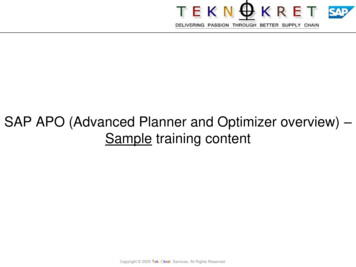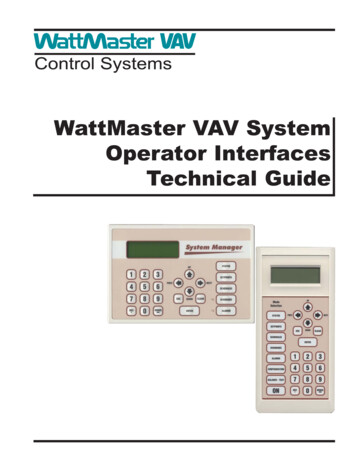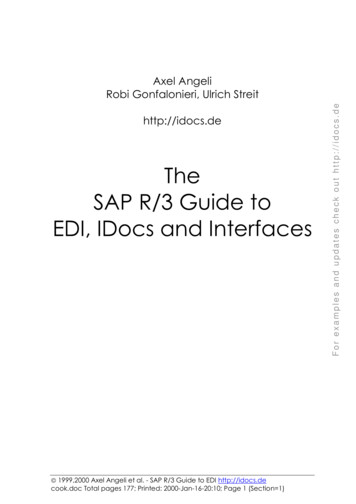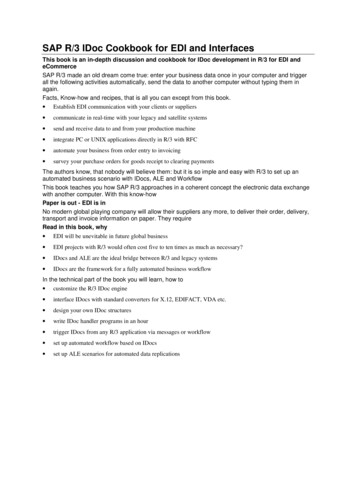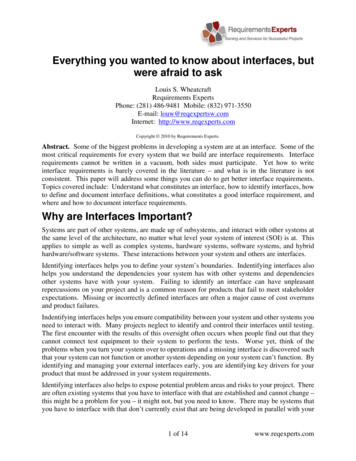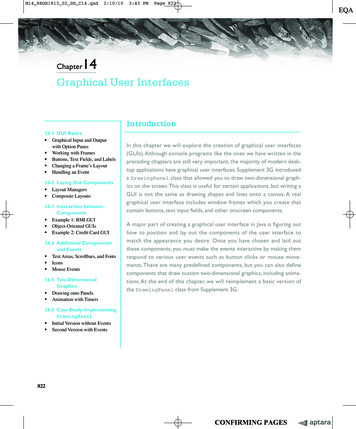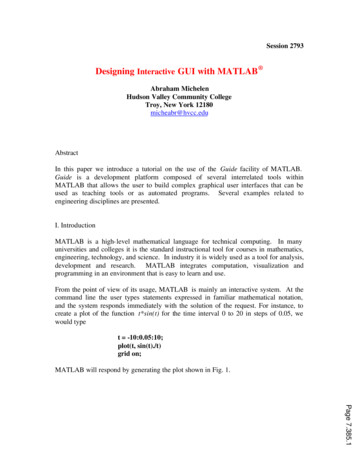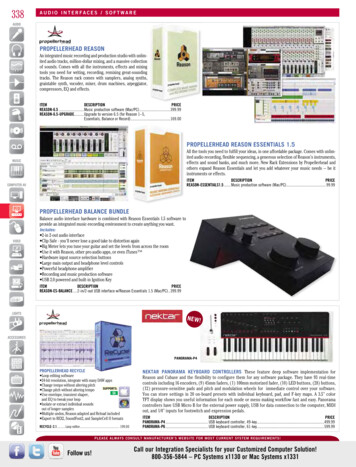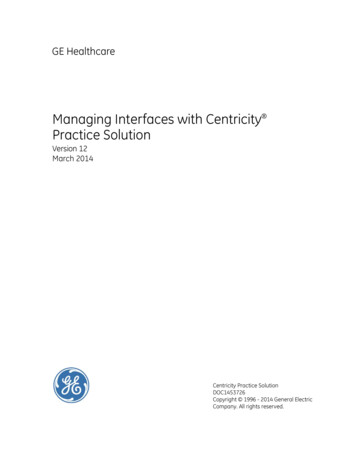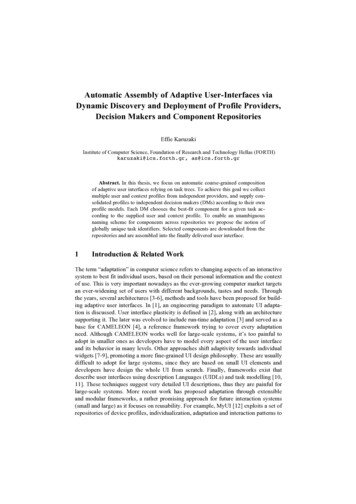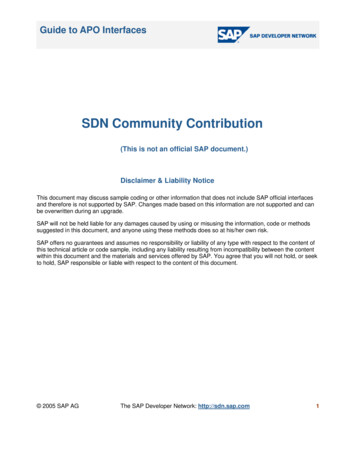
Transcription
Guide to APO InterfacesSDN Community Contribution(This is not an official SAP document.)Disclaimer & Liability NoticeThis document may discuss sample coding or other information that does not include SAP official interfacesand therefore is not supported by SAP. Changes made based on this information are not supported and canbe overwritten during an upgrade.SAP will not be held liable for any damages caused by using or misusing the information, code or methodssuggested in this document, and anyone using these methods does so at his/her own risk.SAP offers no guarantees and assumes no responsibility or liability of any type with respect to the content ofthis technical article or code sample, including any liability resulting from incompatibility between the contentwithin this document and the materials and services offered by SAP. You agree that you will not hold, or seekto hold, SAP responsible or liable with respect to the content of this document. 2005 SAP AGThe SAP Developer Network: http://sdn.sap.com1
Guide to APO InterfacesApplies ToInterfaces from Legacy System to SAP APO.SummaryThe use of Flat File Interfaces in the Client environmentTo implement a flat file interface, the following client standards are applicable:-each interface needs to have an interface identificationdata of the interface is stored in a customer table (interface catalogue)the directory location is stored in a logical file, the logical file name is stored in the customer tablewhen running the interface, we record the start and end date and time, status in a history tablethere are standards for file names, and these are generated automatically by the interface startfunctionthe middleware system does the file transfer based upon the filenamethe security/authorization can be determined on the logical file pathCompany: IBM IndiaDate: 04 October 2005 2005 SAP AGThe SAP Developer Network: http://sdn.sap.com2
Guide to APO InterfacesTable of ContentsDisclaimer & Liability Notice .11Applies To: .22Summary .2The use of Flat File Interfaces in the Client environment.42.1Interface identification .42.2CLIENT Interface Identification table .62.3Logical file name .62.4Physical file path - name .72.5Programming standards for file handling .72.6HEADER / FOOTER RECORD.102.7Error handling .113Screen Shots of Interface tables and parameters of Function modules:.134Specific Interfaces using Interface Controls.184.15Inbound interfaces.18Author Bio.35 2005 SAP AGThe SAP Developer Network: http://sdn.sap.com3
Guide to APO InterfacesThe use of Flat File Interfaces in the Client environmentTo implement a flat file interface, the following client standards are applicable:1.1each interface needs to have an interface identificationdata of the interface is stored in a customer table (interface catalogue)the directory location is stored in a logical file, the logical file name is stored in the customer tablewhen running the interface, we record the start and end date and time, status in a history tablethere are standards for file names, and these are generated automatically by the interface startfunctionthe middleware system does the file transfer based upon the filenamethe security/authorization can be determined on the logical file pathInterface identificationAn interface key will uniquely identify each batch interface. The key consists of 3 parameters and logicallydescribes the source, destination and content of any interface file. Organizational Unit: This represents the logical business unit within Client that is responsible for theinterface. This could be the CLIENT center, a region, a market or a subsidiary within a market.Example :0000Client Center – Globally managed interfaceCH11 Client Suisse SAGB11 Client UKFor outbound interfaces the organizational unit indicates the origin of the data. For inbound interfaces theorganizational unit identifies the destination of the data.For each organizational unit a separate batch schedule will be set up with the holiday and factorycalendar specific to that region/market/subsidiary. For this reason we will make use of company codes todescribe the organizational unit. In case the organizational unit is not a legal client entity (e.g. the AMSregion as a whole) we will make use of dummy company codes and maintain these in a separate table. External system / partner : This represents the name of the external partner or legacy system thatreceives/sends the interface file. This can correspond to an actual legacy system or can be the name ofan EDI partner. 2005 SAP AGThe SAP Developer Network: http://sdn.sap.com4
Guide to APO InterfacesThe external system / partner needs to be stored in customer table /EURGLB/XEEXTPAR: CLIENTExternal Partner Master (see also appendix). Interface Identifier : This describes the type of message being sent to/from the external partner. It iseffectively a unique name for a CLIENT standard plug-in.Example :FICAR01CSORD01EDI order interfaceCSINV01EDI invoice interfaceCARAT Common interface – POPL messageThe interface identifier describes what kind of data is in the file.The interface identifier needs to be stored in customer table /EURGLB/XEINTMAS: CLIENT Interface IDMaster.Naming convention for this field is now PPDMMMMMNNWhere: PP Process area e.g. ‘FI’DDirection (I - Inbound; O - Outbound)MMMMM Message content (ORD - Orders, PRDPL - Product P&L, etc). Essentially 5 bytes todescribe the message.NN Sequence number. This is used to uniquely identify interface programs with similarcontent. Example - Both R/3 core and CRM have orders inbound interfaces.For each interface the 3 parameters above answer the following questions : Who is the data from?Who is the data for?What data is in the file?(organizational unit for outbound / External system for inbound)(organizational unit for inbound / External system for outbound)(interface identifier)These three identifiers will be used to save the specific information about the interface, to save the run historyand it is also used in the filename, and consequently in the middleware system as routing mechanism.When a new interface is created, you first have to check that there is not an existing interface. Therefore youneed to contact interface coordinator. This person will check the interface catalogue and check for similarinterfaces and he will give the name of the external system and the interface identifier to be used for the newinterface. 2005 SAP AGThe SAP Developer Network: http://sdn.sap.com5
Guide to APO Interfaces1.2CLIENT Interface Identification tableAll interfaces are stored in this CLIENT Interface Identification table: see table /EURGLB/XEINTID in section2.For maintenance, see transaction SM30 for this table.The interface coordinator is owner of this table but each development coordinator is for having the rightentries in this table for his own interfaces.1.3Logical file nameThe standards of the logical file name are described in a document of the basis team (see also appendix).See above: shortcut to document: Standards-SIDLogicalSystemsClients.Use transaction FILE to create the logical file.The following set-up is used in CLIENT:- no logical path definition is created- all information is stored in the logical file name definitionSee picture below. 2005 SAP AGThe SAP Developer Network: http://sdn.sap.com6
Guide to APO Interfaces1.4Physical file path - nameThe standards for the physical file path are stored in the following document: (See also appendix).See above: shortcut to document: Standards-SIDLogicalSystemsClients.The concept of the interface identification key is maintained also in the file name. This will reduce complexitywithin SAP and will give the adapter a key with which to determine routing information for the middleware.The file name consists of:[ORGANIZATIONAL UNIT] .[EXTERNAL SYSTEM] .[INTERFACE IDENTIFIER] .[SEQUENCE NUMBER] . DATFor example an interface with Organizational unit Client Suisse (CH11)External system CHEINFO Interface identifier FIOTRPRC01with file number 176will have as file name : CH11. CHEINFO . FIOTRPRC01.000000000176.DATThe middleware system normally uses only the organizational unit, external system and interface identifier toidentify the correct route for the file.1.5Programming standards for file handlingWhen the file starts, we have to call function /EURGLB/X INTERFACE START PROC.When ending the interface, we have to call function /EURGLB/X INTERFACE END PROC.We have a specific header and footer: see structure/EURGLB/XINTERFACE FOOTER and structure /EURGLB/XINTERFACE HEADER.1.5.1/EURGLB/X INTERFACE START PROCThe function has the following importing parameters:BUKRSINTID 2005 SAP AG: Organizational unit: Interface identifierThe SAP Developer Network: http://sdn.sap.com7
Guide to APO InterfacesPARNUM: Partner numberINPUT FILENAME: Local file for upload/downloadPARALLEL RUNS ALLOWED: Parallel runs allowed 'X', if the flag is set, the last interface run isnot checked to not have status 'in process'.NORMAL RUN: Run mode normal 'X', if the flag is not set, the function assumes itis a rerun and it will get validated with the last sequence number andno new entry will be created in the history tableTEST RUN: Test run 'X': if set, there is not updating of the history tableNO SEQ CHECK: No sequence check 'X', if set, there is no check on the sequencenumber for inbound filesNO HEAD FOOTER: No header nor footer, if set, no checks are performed on the headeror footer, and the header and footer are not removedExporting parameters:XEINTIDPHYSICAL FILENAME: CLIENT Interface Identification table: Logical file nameHEADER: Interface header recordTable parameters:INPUT FILE: EDI Interface file structureFunctionality of the Function Module. Based upon the organizational unit, interface identifier and partner number, table /EURGLB/XEINTIDis read. This gives the specific interface information.All interface information for this interface is selected by the history table /EURGLB/XEINTHIS andsorted by date and timeIf the flag PARALLEL RUNS ALLOWED is not set, then we check that the last specific interface runis not in status 'In process'.The header records is now filled using the information from /EURGLB/XEINTID, the date and time isset to the current date and time. The sequence number is the current sequence number of the lastinterface added by 1. 2005 SAP AGThe SAP Developer Network: http://sdn.sap.com8
Guide to APO Interfaces We get the physical path using function FILE GET NAME using the logical file name stored in table/EURGLB/XEINTID. For inbound interfaces, the physical path is concatenated with the file name. Foroutbound interfaces, the same is done if the filename is not empty. If the filename INPUT FILENAMEis empty, the following filename is built:physical path XEINTID-BUKRS '.' XEINTID-PARNUM '.' XEINTID-INTID '.' new sequencenumber '.DAT'If it is inbound interface, some additional checks are done:o The file is opened and completely read into table parameter INPUT FILE.o If the flag NO HEAD FOOTER is not set and NORMAL RUN is set, the header is read andchecked: record type, sequence number, partner number. The footer records is also read andchecked: record type is checked and also the number of recordso The header and the footer are removed from the table parameter INPUT FILE.If the TEST RUN parameter is empty, then the history table /EURGLB/XEINTHIS is updated with thecurrent date and time if the status is not 'in process', otherwise the time stamp is not changed.During Inbound interface processing the HEADER and FOOTER are provided in the file.During Outbound interface processing The HEADER will be built by function module /EURGLB/X INTERFACE START PROC, but will stillneed to be written into the file by the interface codeThe FOOTER record needs to be built and written into the file by the interface code.1.5.2/EURGLB/X INTERFACE END PROCThis function is to be called at the end of the interface processing.The function has the following importing parameters:HEADER: Interface header recordSTATUS: StatusRECCT: Total records of the fileTRANS: Number of transactionsERRCT: Number of incorrect transactionsTEST RUN: Test runMEMHOLDTYPE : Free Text (e.g. last record processed) 2005 SAP AGThe SAP Developer Network: http://sdn.sap.com9
Guide to APO InterfacesThere are no export parameters nor table parameters.The following statuses are valid:'in process' : 1'successfully finished' : 2'Failure': 3The function updates the specific record using the HEADER record information in the history table/EURGLB/XEINTHIS. If the status is not in process, then the current date and time is set, otherwise the timestamp is not changed.1.6HEADER / FOOTER RECORD1.6.1HEADER RECORDRegardless of the content of the file, the first record of any interface flat file should always be the HEADERrecord. It consists of the following fields :FieldDescriptionTypeSizeValueset / ExampleRECTYPERecord typeCHAR10'HEADER'BUKRSOrganizational UnitCHAR4e.g.: '0937' (Client Suisse)PARNUMExternal partner / systemCHAR10e.g.: 'CARAT'INTIDInterface IdentifierCHAR12e.g.: 'CSINV01'SEQNOFile sequence number (tableXEINTHIS keeps log of previoussequence numbers for thisinterface)NUMC12e.g.: '000000000005' 2005 SAP AGThe SAP Developer Network: http://sdn.sap.com10
Guide to APO InterfacesBEGDAFile creation dateDATS8YYYYMMDDBEGTIFile creation timeTIMS6HHMMSSThis record is defined as structure /EURGLB/XINTERFACE HEADER in the data dictionary.1.6.2FOOTER RECORDRegardless of the content of the file, the last record of any interface flat file should always be the FOOTERrecord. It consists of the following fields :FieldDescriptionTypeSizeValueset / ExampleRECTYPERecord typeCHAR10'FOOTER'RECORDSTotal number of records in fileNUMC12e.g.: '000000000100'TRANSTotal number of LUWs in fileNUMC12e.g.: '000000000025'CHKSUMControl checksum value (is basedon a control algorithm)NUMC25e.g.: '000000000012586'This record is defined as structure /EURGLB/XINTERFACE FOOTER in the data dictionary.1.7Error handlingThe /EURGLB/X INTERFACE START PROC function and the /EURGLB/X INTERFACE END PROCfunction return specific exceptions back to the calling program whenever errors for these functions.The calling program can decide how to handle this exceptions. However, if an entry is already made in thehistory table, the purpose is to set the status to 3:failure. If there were no errors, the status should be set to 2:success. This change is done when you call the /EURGLB/X INTERFACE END PROC function with theproper import parameters. 2005 SAP AGThe SAP Developer Network: http://sdn.sap.com11
Guide to APO InterfacesIf an interface has the status in process and a new interface run is requested with the optionPARALLEL RUNS ALLOWED space, then an the interface start function will return an exception. In thissituation, the entry in the history table with the status in process has to be checked and if there is not interfacerunning anymore and all reconciliation activities have taken place, the status should be changed in the table.It is possible to code (within the interface program itself) sending the output report via SAPMail to designatedusers in the case of error. The fields /EURGLB/XEINTID-BUS AGENT TYPE, /EURGLB/XEINTIDBUS AGENT, /EURGLB/XEINTID-IS AGENT TYPE, /EURGLB/XEINTID-IS AGENT are used to determinewhere the output should be directed. The EDI Orders interface program/EURGLB/VGTRB EDI ORDERS INT is a good example of this functionality. 2005 SAP AGThe SAP Developer Network: http://sdn.sap.com12
Guide to APO Interfaces2 2005 SAP AGScreen Shots of Interface tables and parameters of Function modules:The SAP Developer Network: http://sdn.sap.com13
Guide to APO Interfaces 2005 SAP AGThe SAP Developer Network: http://sdn.sap.com14
Guide to APO Interfaces 2005 SAP AGThe SAP Developer Network: http://sdn.sap.com15
Guide to APO Interfaces 2005 SAP AGThe SAP Developer Network: http://sdn.sap.com16
Guide to APO Interfaces 2005 SAP AGThe SAP Developer Network: http://sdn.sap.com17
Guide to APO Interfaces33.1Specific Interfaces using Interface ControlsInbound interfaces3.1.1Interface for Transferring stock from Legacy to Client AP0.LegacyAPO dataretrievedand sent toGloffiGloffi places fileon securedirectory for MWto pick upautomaticallyMW picks upfile andplaces onSAPapplicationserver.SAP APOprogramsexecuted andprocesses thefile in zdatadirectoryLivecache andDatabaseupdated inClient APO1.2.3.4.5.Data is extracted from the Legacy APO and put in a secured directory in Gloffi.GLOFFI polls directory for any new filesGLOFFI wrapper program adds header and footerGLOFFI places file on secure directory for MW to pick up automaticallyMW picks up file and performs mapping exercise and places on designated secure directory on SAPapplication server (zdata directory)6. The SAP custom developed wrapper program /EUR/AEUPDO STOCK FORECAST is executed andprocesses the file from the application server.7. In Client APO Livecache and Database is updated. 2005 SAP AGThe SAP Developer Network: http://sdn.sap.com18
Guide to APO InterfacesLocal support team – needs to ensure that the relevant people have access to the secured directoriesGLOFFI access - The polling job needs to have a user id set up1. For Test – which will be used for test and integration testing (MIT)2. For Production – which will be used for pre-production (MAT) and Production3. With a non-expiring password – this will only be used by the application to access the networkdirectory.4. The User ids needs access to Read, Write access to Local server where the software runs and writeaccess to the GLOFFI server.3.1.1.1SAP ComponentsExample below shows how the Stock Upload works on the SAP side. The process will be the same for UKand Ireland, but the interface controls will vary.File will arrive in SAP Directory /zdata/EBJ/gb/apo/glb/pdostock01Name: gb11.gbeapo.pd0stock01.00000001.datThe report /EUR/AEUPDO STOCK FORECAST is executed with a variant. 2005 SAP AGThe SAP Developer Network: http://sdn.sap.com19
Guide to APO Interfaces* Geting the current logical system name.call function '/EURGLB/X INTERFACE START PROC'exportingbukrsintid fp bukrs fp intidparnum fp rcvprninput filename l fileparallel runs allowed l c keynormal run l c keyimportingphysical filenameheader fp v phy file l rec headerexceptionsinvalid interface 1last run executingfile not found 2 3no header recordno footer record 4 5incorrect no records 6
Example : CSORD01 EDI order interface CSINV01 EDI invoice interface FICAR01 CARAT Common interface – POPL message The interface identifier describes what kind of data is in the file. The interface identifier needs to be stored in customer table /EURGLB/XEINTMAS: CLIENT Interface ID M
